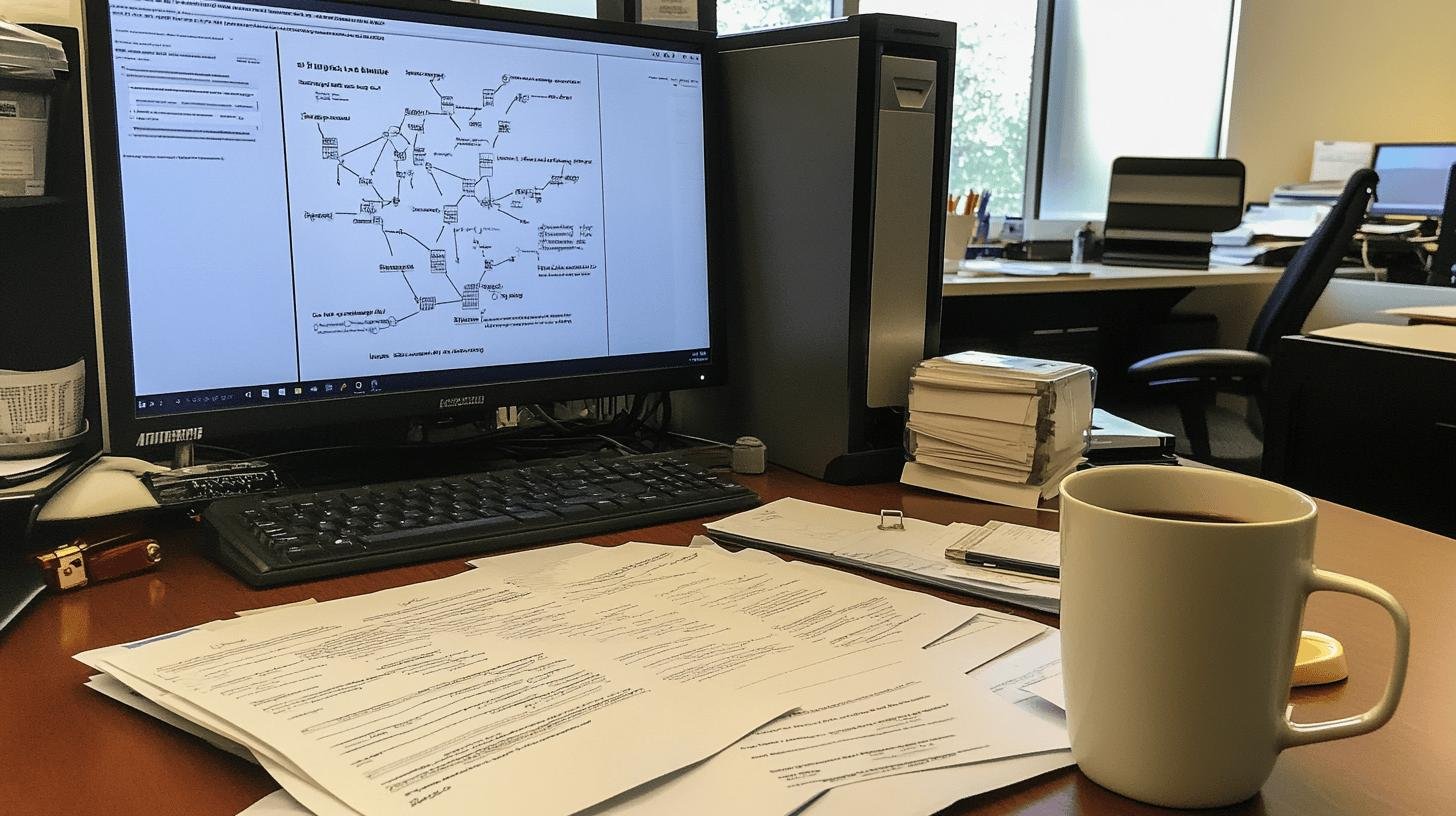TL;DR:
- Risk Management Tools are vital for identifying and managing project uncertainties.
- Tools Include:
- Risk Assessment Matrix: Prioritizes risks based on likelihood and impact.
- SWOT Analysis: Analyzes strengths, weaknesses, opportunities, and threats.
- Simulation Software: Models various risk scenarios (e.g., Monte Carlo).
- Decision Trees: Visualizes decisions and outcomes.
- Risk Register: Tracks identified risks and mitigation strategies.
- Benefits: Enhances project success, improves resource allocation, and reduces delays or failures by systematically managing risks.
Can you imagine putting months of hard work into a project, only to watch it crumble because of unexpected risks? That’s why savvy project managers never gamble—they use risk management tools to stack the odds in their favor. These tools, like risk assessment matrices and SWOT analyses, are the unsung heroes behind successful ventures. They help pinpoint potential pitfalls before they turn into full-blown disasters.
This article breaks down popular risk management techniques and shows how these strategies can boost your project’s success. Ready to make risk work for you?
Exploring Popular Tools of Risk Management
Risk management tools are crucial in any project or industry facing uncertainties. These tools help identify, evaluate, and manage risks, leading to informed decisions and efficient resource use. By using these tools effectively, organizations can foresee challenges and develop proactive strategies. This ensures smoother project execution and boosts success rates.
- Risk Assessment Matrix: This tool helps prioritize risks by categorizing them based on likelihood and impact.
- SWOT Analysis: A strategic tool to analyze a project’s strengths, weaknesses, opportunities, and threats.
- Simulation Software: Tools like Monte Carlo simulations model various risk scenarios to guide decisions.
- Decision Trees: These visual maps of decisions and outcomes help evaluate different actions.
- Risk Register: A living document tracking identified risks, their severity, and mitigation steps.
Together, these tools enhance an organization’s capability to handle uncertainties. By using them, teams ensure projects finish on time, within budget, and with desired quality. These tools are indispensable in the landscape of risk management.
The Role of Risk Assessment Matrices in Risk Management

A risk assessment matrix is a visual tool for categorizing risks by probability and impact. This helps organizations identify which threats need first attention. By mapping out risks, decision-makers can plan efficiently. They allocate resources where needed, minimizing unforeseen impacts on success.
| Risk Level | Probability | Impact |
|---|---|---|
| Low | Unlikely | Minor |
| Medium | Possible | Moderate |
| High | Likely | Severe |
| Critical | Almost Certain | Catastrophic |
Using a risk assessment matrix focuses teams on high-risk areas. This reduces the chance of project delays or failures. Systematic risk evaluation improves management strategies, leading to more successful outcomes.
Applying SWOT Analysis for Strategic Risk Management
SWOT analysis, which stands for Strengths, Weaknesses, Opportunities, and Threats, provides a comprehensive view of a project or business. By analyzing these four areas, teams identify factors affecting success, both positively and negatively.
Strengths and weaknesses are internal, showing what a team does well and where it can improve. Opportunities and threats are external, highlighting market trends or potential challenges.
SWOT analysis helps in risk management by clarifying current positions and predicting potential changes. This is crucial for forming strategies that leverage strengths, address weaknesses, capitalize on opportunities, and mitigate threats.
SWOT offers a clear snapshot of a project’s environment for identifying risks and opportunities. This insight assists decision-makers in prioritizing actions and allocating resources effectively. By addressing each component, organizations boost project success and adapt efficiently to changing conditions.
Simulation Software and Decision Trees in Risk Management

Simulation software, like Monte Carlo simulations, is powerful in proactive risk management. It models various scenarios, predicting possible outcomes by calculating the probability of different events. This helps organizations visualize potential risks and their impacts, leading to informed decision-making.
Decision trees provide a visual map of potential decisions and their consequences. They break down complex decisions into manageable parts, showing paths from decisions to outcomes. This clarity helps teams evaluate risks associated with each decision, making it easier to choose the best course of action.
Real-World Application of Simulation Software and Decision Trees
In finance, simulation software and decision trees manage investment risks. Monte Carlo simulations predict the probability of different investment returns, aiding managers in assessing risks. Decision trees map investment strategies, illustrating outcomes of financial decisions. These tools help analysts make informed choices, optimize strategies, and minimize losses.
Utilizing Risk Registers for Effective Risk Monitoring
A risk register is a comprehensive document listing identified risks, their severity, and the steps to mitigate them. It serves as a dynamic tool evolving throughout a project’s lifecycle. Recording risks centrally helps teams track and manage issues effectively.
Maintaining a risk register improves communication among team members and enhances risk monitoring. By documenting risks and strategies systematically, teams prioritize actions and allocate resources efficiently. This ensures critical issues receive attention, minimizing surprises and keeping projects on track, contributing to overall success.
Final Words
Diving into risk management tools provides valuable insights into handling uncertainties. Tools such as risk assessment matrices, SWOT analysis, simulation software, decision trees, and risk registers play crucial roles in assessing, evaluating, and mitigating risks effectively. Each tool, from visual matrices and strategic SWOTs to simulation software, aids informed decision-making.
Risk registers ensure continuous tracking and management. Together, these tools create a comprehensive framework for navigating potential threats. Understanding and utilizing these tools can enhance decision-making and resource allocation, leading to more secure and successful projects.
FAQ
What are the main tools used for risk management?
Tools like risk assessment matrices, SWOT analysis, simulation software, decision trees, and risk registers help manage uncertainties by identifying, evaluating, and mitigating risks, supporting better decision-making.
What are the 5 risk assessment tools?
The five commonly used risk assessment tools are the risk assessment matrix, which evaluates the severity and likelihood of risks; SWOT analysis, which examines strengths, weaknesses, opportunities, and threats; simulation software, which models risk scenarios and predicts outcomes; decision trees, which visually map decisions and potential results; and the risk register, which tracks and manages identified risks to ensure effective handling and mitigation.
What is the best risk management tool?
The best tool depends on the context but frequently used ones include the Risk Assessment Matrix for prioritizing risks and Simulation Software for modeling scenarios.
Which is the most famous tool of risk management?
The Risk Assessment Matrix is widely recognized for its effectiveness in visualizing and prioritizing risks based on their probability and impact.
Are risk management tools different in industries such as insurance and healthcare?
While core tools like Risk Assessment Matrix and SWOT Analysis are standard, industries like insurance and healthcare might utilize specialized tools tailored to their specific risks and regulatory requirements.
What roles do simulation software and decision trees play in risk management?
Simulation Software, like Monte Carlo simulations, tests risk scenarios, while Decision Trees map potential decisions and outcomes, aiding in proactive risk analysis and management.
How do risk registers help in risk monitoring?
Risk registers document and track risks, their severity, and mitigation steps, providing an ongoing record for effective risk management throughout a project’s lifecycle.

